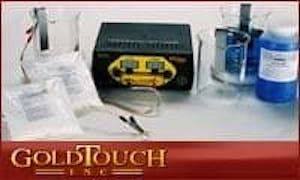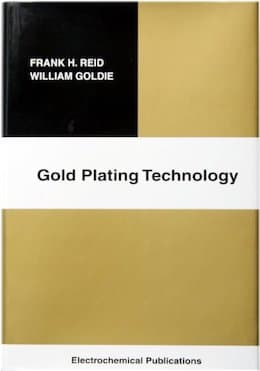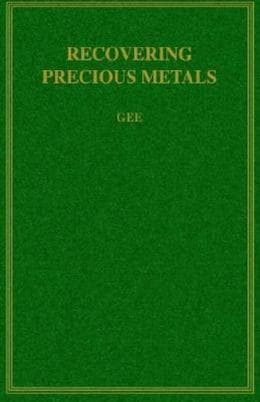
-----
Contamination of gold plating bath, removing contaminants
adv.
Brush plating equipment, chemicals, and supplies from Gold Touch

Q. My company is running gold plating and we noticed the nickel content is getting higher in the gold bath to about 5g/L. Will this affect the quality of the plating? It seems that the nickel comes from immersion, is there any way to prevent that from happening? Thank you!
WH Ngoi- Singapore
March 23, 2022
A. Hi Ngoi. There is a good discussion on that subject on this thread, but in case you miss it ... In gold plating, a gold strike not only improves adhesion, but it also serves as a garbage collector, trapping those contaminants in a weaker, less expensive, more disposable solution rather than letting them contaminate your concentrated and expensive gold plating solution.
Luck & Regards,

Ted Mooney, P.E. RET
Striving to live Aloha
finishing.com - Pine Beach, New Jersey
Ted is available for instant help
or longer-term assistance.
March 2022
⇩ Related postings, oldest first ⇩
Q. I work in a plating shop that does quite a bit of Soft Gold plating I'm having a problem with nickel contamination in our Soft Gold plating bath. Does anyone know how nickel concentration can be reduced without resorting to high current density dummying? The bath is performing fine, but we are about to exceed self-imposed specifications for nickel contamination. Any suggestions would be appreciated, as I would rather not have to rebuild the bath.
Thanks!
Jacob Hendricksonplating shop - Seattle, Washington, USA
2004
by Reid & Goldie
-- hard to find & expensive; if you see a copy cheap, act fast!

on eBay or Amazon
or AbeBooks
(affil link)
A. Mr Hendrickson,
The nickel present in your solution will more than likely be the complex: nickel tetracyanide. This is a rather stable complex and I have had similar problems with my silver plating bath in the past. I have been quoted a figure of 30 g/liter as the top spec limit for this complex and achieved a 100% pure silver deposit at this level of nickel tetracyanide (an orange coloured complex).I know from experience of no safe or effective way of removing, or 'breaking', this complex or even whether 'dummying' your bath at LOW current density would be effective. As such my advice would be to RENEW this bath if practical or economical if you are indeed reaching this critical threshold of 30 g/l. I hope this helps.
Good luck!
Nigel D Gill,B.Sc. MIMF AIEMA MRSC- Glasgow, Scotland
2004
A. As you have no free cyanide in an gold electrolyte, you won't get an Nickel-cyanide complex. One way for removal is to use an cation-ion exchanger, which will remove the nickel cation , but not the Gold-cyanide complex which is an anion. Your supplier of your bath or any other supplier of gold electrolytes should be able to provide you with special cation ion exchanger for this job.
Marcus Hahn- Lucerne, Switzerland
2004
2004
A. We used to do a lot of lead frame plating with pure gold during the 1970's. The gold bath was a so called neutral bath that operated at pH 6-7 and 160 deg F. No free cyanide but the gold was added as PGC. When the sum of the concentrations of nickel, iron and copper totaled 50 ppm we would treat the bath with a stoichiometric amount of sulfide. I remember that it was a polysulfide and would stink quite a bit. But it did precipitate out all of the impurities and allowed us to continue to use the bath till the specific gravity got too high.
The polysulfide was available from ACR which is now part of Technic. You should check with them and see if it is still being sold.

Pat Mentone
St Paul, Minnesota
Q. I'm a chemical supplier for a flexible board company applying soft gold plating in their fad. Recently, they encountered problem in their customer site and would like us to conduct a test that would give the contaminants of the soft gold solution. My problem is they want to know the organic and non-organics contaminants that is present in the soft gold solution. They requested us to use HPLC to determine this contaminants but so far I cannot find a local analytical laboratory that will perform this for gold solution. What are the possible organic and non organic contaminants for gold plating solution? What other equipment can we use to determine this contaminants?
Graciela L. Delos Santoschemicals - Muntinlupa City, Philippines
2005
A. Have you considered asking the supplier of your gold plating chemistry?

James Totter, CEF
- Tallahassee, Florida
2005
2005
A. Graciela,
Best way is to control and stop impurities entering gold plating bath.
Organic impurities: Organic breakdown products of additives,together with drag-in of wetting agents from previous cycles(cleaning/acid dip/plating baths)
Use a strike/flash bath with minimum gold/ltr prior to main bath.This also will prevent impurities entering to the main bath
Removal: Activated carbon treatment- Heat the solution 60 degree> Add activated carbon(1-2 grm/lt) > Stir > Filter within 45 minutes (use vacuum filter)
Metallic impurities:Lead is the main enemy.
Most of other metals like Copper,Nickel,silver etc will co deposit with gold and will get removed though the characteristic of the deposit will change.
Atomic Absorption Spectrometer
⇦ on
eBay
or
Amazon [affil link] is the best equipment to detect in ppm level of these impurities.
The best approach to the problem is to prevent impurities entering the bath.
In case of severe metallic contamination it will be more economical to dump the bath and make fresh bath.

T.K. Mohan
plating process supplier - Mumbai, India
A. You did not state the electrolyte so I will assume it is citric or phosphoric. In either case the gold is probably present as potassium gold cyanide which is stable down to pH 3.1. or 3.2. When the gold is plated out of the complex the cyanide (in that acid medium) forms a long chain organic polymer which lowers the electrical plating efficiency. At some point this polymer must be carbon treated out using sulfur free powdered activated carbon.
This should be the only excuse for organics to be there.
Any other organics or any inorganics (in a pure soft gold solution) must be dragged in with sloppy procedures.

Robert H Probert
Robert H Probert Technical Services
Garner, North Carolina

2005
A. Use AA machine (HPLC machine) to check PPM of metallic contamination
John Tang- Hong Kong
March 14, 2013
Q. Dear sir,
I am an employee in plating industry and come to you to know the analysis process of acid gold (cobalt base). Please help me in this matter.
thanks
regards
employee in plating ind. - jaipur, rajasthan INDIA
November 18, 2010
How to remove copper contamination from gold bath
Q. How to remove copper (PPM) contamination from Neutral Gold bath?
Vijay KansupadaPlating and Anodizing - Columbia South Carolina
June 30, 2015
A. You cannot!! Bite the bullet, send it in for refining. When you start back up, use a gold strike as a "sewer" to catch the copper so that your expensive plating solution only "sees" gold and stays pure.

Robert H Probert
Robert H Probert Technical Services
Garner, North Carolina

June 30, 2015
Gold will only plate at 0.4 ASD (4 ASF) and above
Q. Hi,
I am working on cyanide gold plating, I used to apply 0.2 ASD to electroplate gold on wafer but with a new plating bath make-up I encountered uneven plating on a 100x100 µm feature (peak-peak ranges from 0.3 µm ~ 13 µm). Recommended plating ASD from chemical supplier ranges from 0.1 ~ 1.0 ASD. With 0.4 ASD, I am able to get good uniformity. Found old plating bath with significant low conductivity when compared to the newly made up bath. Any explanation why 0.4 ASD works and not 0.2 ASD, assuming temperature, pH, anode-cathode distance, etc., unchanged? What is the disadvantage of plating at limiting current region?
Thanks!
Semiconductor - Ipoh, Perak, Malaysia
October 4, 2015
A. Hello Chiou. I think you should start with plating a simple Hull Cell ⇦ huh? panel with each bath to try to get a good profile on what is going on.
Regards,

Ted Mooney, P.E. RET
Striving to live Aloha
finishing.com - Pine Beach, New Jersey
Ted is available for instant help
or longer-term assistance.
October 2015
Q. Hello,
My name is Kati. I am working in electronic industry and deal with Gold plating of electronic parts. Recently I have a big problem with contamination in strike bath (I am looking at contaminations like green crystals) and I worry about this situation, because my previous strike solutions were polluted and even carbon filter didn't help. I replaced those solutions to this new one. What you can you recommend to prevent contamination in the baths?
Thank you for your help.
Kati
Electronic industry - Beer Sheva, Israel
May 11, 2016
|
|
A. First determine what is green: Nickel salts? Iron salts? Copper salts? Then stop the entry. If you are striking over raw brass or copper or nickel or Kovar, then enter the strike "hot", that is, make contact to the rack outside the tank, before it enters the strike solution. Be sure there is no a.c. coming thru the rectifier.  Robert H Probert Robert H Probert Technical Services Garner, North Carolina  May 12, 2016 A. Hello Kati, there are two things that come to mind. One is inadequate rinsing before the Au strike bath. If the pre - plate is Ni, green crystals can appear. The second thing that comes to mind is algae. Some platers shut off the tank filtration when the bath is idle. If it is idle for a long time without any movement of the solution, algae will form. This is true in acid Au strikes, not strikes with free cyanide. If you still have the old strike bath you could have an analysis done for metallic impurities. You may find that you have high ppm concentrations of Ni or other metals. If no metallic contaminants are present, keep the bath filtered through a 5 micron filter continuously. Hope this helps! Mark BakerProcess Engineering - Phoenix, Arizona USA May 12, 2016 |
September 17, 2018
Q. Hello,
I have a plating shop in my factory and having a problem with the gold plating process.
We do nickel plating first and then gold plating on stainless steel product.
For the gold, we use PGC (K[Au(CN)2]).
The problem is that the gold color suddenly changed to copper-ish color while it was very yellowish gold only 2 weeks ago.
My engineer says it is because the concentration is lowered.
But there is no way to confirm this statement because we do not have any measurement equipment such as AAS.
He also complained that copper is continuously being added into the bath because of the jig that holds the product which is made of copper.
My question is,
1) If the concentration is too low, can the color be copper-ish (or red-ish)?
2) Can the copper from the jig really added into the solution? (I am a layman in chemistry)
3) Even if the copper can possibly be added into the solution, can the concentration be high enough to change the color of the result?
By the way, we've used the solution for 6+ months. But we rinse the product well after the nickel plating process.
We also produce two-tone (chrome and gold) products that requires masking and peeling(?) of chrome for some part of the product and then gold plating on it.
Due to the masking lacquer (not really sure if this word-choice is correct), my solution is blue-colored (just to give you as much background information as possible).
One more question pops up at this point. Can I remove the contaminants?
The alkaline metals (Cu, Ni, etc.) and the blue-color. Or any other contaminants that could usually build up in the solution.
Thank you very much.
kitchenware - Jakarta, Indonesia
Q. I too have same copper contamination problem. Please some of you help us to resolve this how to remove copper contamination.
a. Vasanth karunakaranEmployee - Chennai, India
October 21, 2021
A. Hi Vasanth.
Pat Mentone has said on this thread that precipitation of contaminants with polysulfide just might be worth trying, but Trevor Crichton has noted on other threads the common sense precaution that analysis must always precede any attempts at purification. On the other hand, Robert Probert says forget it, it's just not practical to remove copper from a gold plating bath.
TK Mohan and other readers say here and elsewhere on the site, and are supported by similar suggestions in the literature, that the correct resolution is to do everything possible to prevent contamination, including using a gold strike bath first as a disposable 'garbage collection' to help keep contaminants out of your plating bath.
General advice from me from posting a quarter million Q&A's on this site for 3 decades, is that begging strangers to help us isn't nearly as effective towards getting a conversation started/restarted as starting the conversation yourself. For example, although you don't know how to remove copper, it seems that you probably do know some of the answers to Duho Rhee's other questions, and could help him and other readers, while getting the conversation restarted for your own needs, by addressing the portions of his question that you can answer. Good luck!
Regards,

Ted Mooney, P.E. RET
Striving to live Aloha
finishing.com - Pine Beach, New Jersey
Ted is available for instant help
or longer-term assistance.
October 2021
Q, A, or Comment on THIS thread -or- Start a NEW Thread
